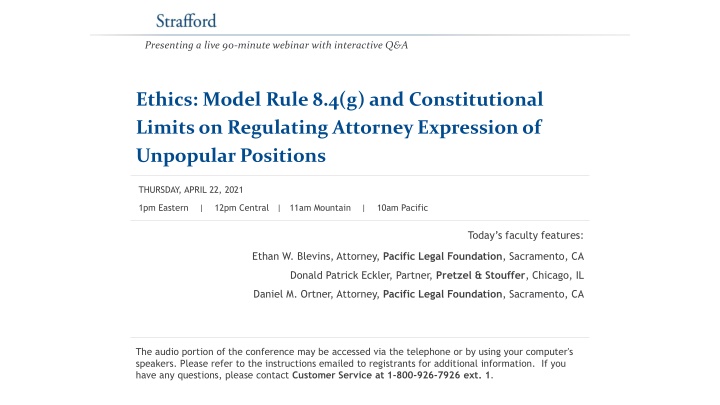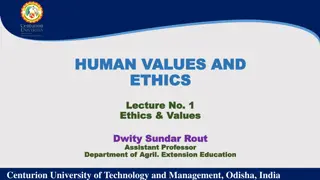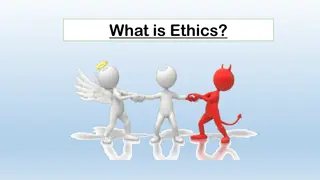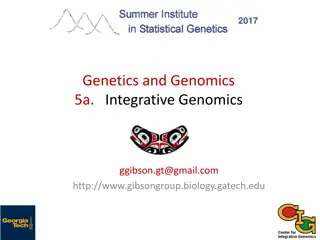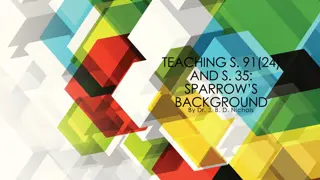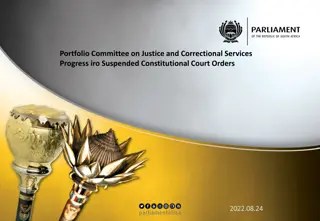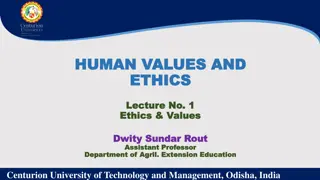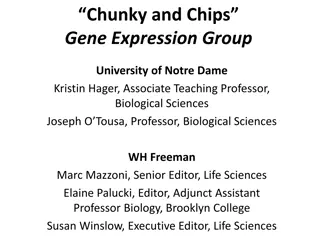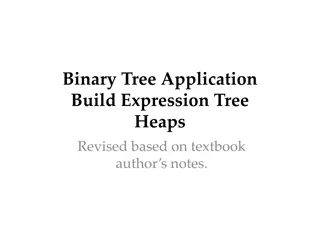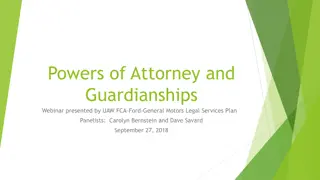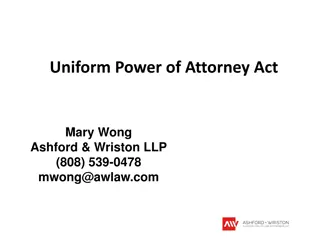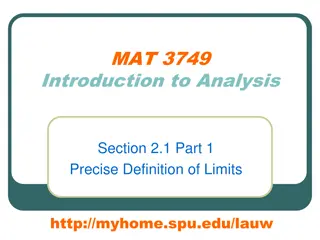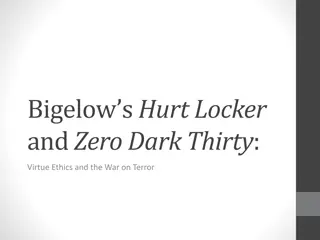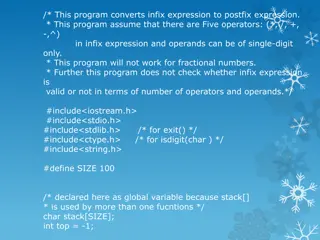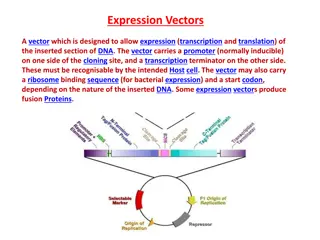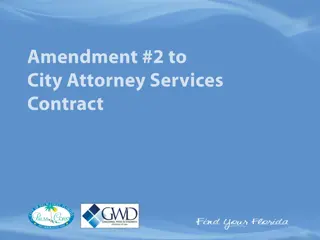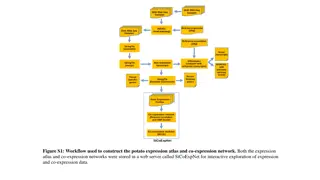Ethics & Constitutional Limits on Attorney Expression Webinar
Join the live 90-minute webinar on Ethics: Model Rule 8.4(g) and Constitutional Limits on Regulating Attorney Expression of Unpopular Positions featuring expert faculty members. Explore regulations governing lawyer speech and the requirements for lawyer communication in various contexts. Learn about the impact of rules like Rule 1.6 on client confidentiality, Rule 3.3 on candor to the tribunal, Rule 3.6 on media statements, Rule 4.3 on dealing with unrepresented individuals, and Rules 7.1-7.3 on service advertising and client solicitation.
Download Presentation

Please find below an Image/Link to download the presentation.
The content on the website is provided AS IS for your information and personal use only. It may not be sold, licensed, or shared on other websites without obtaining consent from the author.If you encounter any issues during the download, it is possible that the publisher has removed the file from their server.
You are allowed to download the files provided on this website for personal or commercial use, subject to the condition that they are used lawfully. All files are the property of their respective owners.
The content on the website is provided AS IS for your information and personal use only. It may not be sold, licensed, or shared on other websites without obtaining consent from the author.
E N D
Presentation Transcript
Presenting a live 90-minute webinar with interactive Q&A Ethics: Model Rule 8.4(g) and Constitutional Limits on Regulating Attorney Expression of Unpopular Positions THURSDAY, APRIL 22, 2021 1pm Eastern | 12pm Central | 11am Mountain | 10am Pacific Today s faculty features: Ethan W. Blevins, Attorney, Pacific Legal Foundation, Sacramento, CA Donald Patrick Eckler, Partner, Pretzel & Stouffer, Chicago, IL Daniel M. Ortner, Attorney, Pacific Legal Foundation, Sacramento, CA The audio portion of the conference may be accessed via the telephone or by using your computer's speakers.Please refer to the instructions emailed to registrants for additional information. If you have any questions, please contact Customer Service at 1-800-926-7926 ext. 1.
FOR LIVE EVENT ONLY Sound Quality If you are listening via your computer speakers, please note that the quality of your sound will vary depending on the speed and quality of your internet connection. If the sound quality is not satisfactory, you may listen via the phone: dial 1-877-447-0294 and enter your Conference ID and PIN when prompted. Otherwise, please send us a chat or e-mail sound@straffordpub.com immediately so we can address the problem. If you dialed in and have any difficulties during the call, press *0 for assistance. Viewing Quality To maximize your screen, press the Full Screen symbol located on the bottom right of the slides. To exit full screen, press the Esc button.
FOR LIVE EVENT ONLY In order for us to process your continuing education credit, you must confirm your participation in this webinar by completing and submitting the Attendance Affirmation/Evaluation after the webinar. A link to the Attendance Affirmation/Evaluation will be in the thank you email that you will receive immediately following the program. For additional information about continuing education, call us at 1-800-926-7926 ext. 2.
FOR LIVE EVENT ONLY If you have not printed the conference materials for this program, please complete the following steps: Click on the link to the PDF of the slides for today s program, which is located to the right of the slides, just above the Q&A box. The PDF will open a separate tab/window. Print the slides by clicking on the printer icon.
Regulation of Lawyer Speech Regulation of Lawyer Speech There are a number of rules that currently regulate lawyer speech and even mandate that lawyers to speak in certain situation: Rule 1.6 restricts disclosure of client confidential information Rule 3.3 candor to the tribunal Rule 3.6 restricts what a lawyer can say in the media about a case Rule 4.3 must disclose that the lawyer is not disinterested in dealing with an unrepresented person Rule 7.1-7.3 restricts what a lawyer can say about their services and how a lawyer may solicit clients. 5
Regulation of Lawyer Speech Regulation of Lawyer Speech The courts have upheld regulations on lawyer advertising. Bates v. St. B. of Ariz., 433 U.S. 350(1977) (upholding restrictions on lawyer advertising) Florida B. v. Went for It, Inc., 515 U.S. 618 (1995) (upholding prohibition on direct mail solicitation of personal injury or wrongful death clients within 30 days of accident) Gentile v. St. B. of Nev., 501 U.S. 1030 (1991); cf. Ohralik v. Ohio St. B. Ass'n, 436 U.S. 447 (1978) (upholding restriction on personal solicitation) 6
Regulation of Lawyer Speech Regulation of Lawyer Speech Why are these restrictions permitted? What do they have in common? They relate to the administration of justice and to the representation of a client. 7
Regulation of Lawyer Speech Regulation of Lawyer Speech Prior to the adoption of Rule 8.4(g) by the American Bar Association there were about 20 states that had some form rule regulating discrimination by lawyers. 29 states have adopted comments to their rules regarding discrimination including 13 states that have not yet promulgated a similar rule, and two states that have declined to adopt the Rule 8.4(g), while New Mexico and Vermont have and Pennsylvania adopted a version that was struck down. 8
Regulation of Lawyer Speech Regulation of Lawyer Speech Typical of many of these rules prior to Model Rule 8.4(g) s adoption by the ABA was Illinois Rule of Professional Conduct 8.4(j): It is professional misconduct for a lawyer to: (j) violate a federal, state or local statute or ordinance that prohibits discrimination based on race, sex, religion, national origin, disability, age, sexual orientation or socioeconomic status by conduct that reflects adversely on the lawyer s fitness as a lawyer. Whether a discriminatory act reflects adversely on a lawyer s fitness as a lawyer shall be determined after consideration of all the circumstances, including: the seriousness of the act; whether the lawyer knew that the act was prohibited by statute or ordinance; whether the act was part of a pattern of prohibited conduct; and whether the act was committed in connection with the lawyer s professional activities. No charge of professional misconduct may be brought pursuant to this paragraph until a court or administrative agency of competent jurisdiction has found that the lawyer has engaged in an unlawful discriminatory act, and the finding of the court or administrative agency has become final and enforceable and any right of judicial review has been exhausted. 9
Regulation of Lawyer Speech Regulation of Lawyer Speech Contrast with Washington Rule of Professional Conduct 8.4(g): It is professional misconduct for a lawyer to: (g) commit a discriminatory act prohibited by state law on the basis of sex, race, age, creed, religion, color, national origin, disability, sexual orientation, honorably discharged veteran or military status, or marital status, where the act of discrimination is committed in connection with the lawyer's professional activities. In addition, it is professional misconduct to commit a discriminatory act on the basis of sexual orientation if such an act would violate this Rule when committed on the basis of sex, race, age, creed, religion, color, national origin, disability, honorably discharged veteran or military status, or marital status. This Rule shall not limit the ability of a lawyer to accept, decline, or withdraw from the representation of a client in accordance with Rule 1.16; 10
Regulation of Lawyer Speech Regulation of Lawyer Speech Contrast with Washington Rule of Professional Conduct 8.4(h): It is professional misconduct for a lawyer to: (h) in representing a client, engage in conduct that is prejudicial to the administration of justice toward judges, lawyers, or LLLTs, other parties, witnesses, jurors, or court personnel or officers, that a reasonable person would interpret as manifesting prejudice or bias on the basis of sex, race, age, creed, religion, color, national origin, disability, sexual orientation, honorably discharged veteran or military status, or marital status. This Rule does not restrict a lawyer from representing a client by advancing material factual or legal issues or arguments; 11
History of Rule 8.4(g) History of Rule 8.4(g) Let s start with the language of ABA Model Rule 8.4(g): It is professional misconduct for a lawyer to: (g) engage in conduct that the lawyer knows or reasonably should know is harassment or discrimination on the basis of race, sex, religion, national origin, ethnicity, disability, age, sexual orientation, gender identity, marital status or socioeconomic status in conduct related to the practice of law. This paragraph does not limit the ability of a lawyer to accept, decline or withdraw from a representation in accordance with Rule 1.16. This paragraph does not preclude legitimate advice or advocacy consistent with these Rules. 12
History of Rule 8.4(g) History of Rule 8.4(g) The comments are also critical to understanding the Rule: [3] Discrimination and harassment by lawyers in violation of paragraph (g) undermine confidence in the legal profession and the legal system. Such discrimination includes harmful verbal or physical conduct that manifests bias or prejudice towards others. Harassment includes sexual harassment and derogatory or demeaning verbal or physical conduct. Sexual harassment includes unwelcome sexual advances, requests for sexual favors, and other unwelcome verbal or physical conduct of a sexual nature. The substantive law of antidiscrimination and anti- harassment statutes and case law may guide application of paragraph (g). 13
History of Rule 8.4(g) History of Rule 8.4(g) The comments are also critical to understanding the Rule: [4] Conduct related to the practice of law includes representing clients; interacting with witnesses, coworkers, court personnel, lawyers and others while engaged in the practice of law; operating or managing a law firm or law practice; and participating in bar association, business or social activities in connection with the practice of law. Lawyers may engage in conduct undertaken to promote diversity and inclusion without violating this Rule by, for example, implementing initiatives aimed at recruiting, hiring, retaining and advancing diverse employees or sponsoring diverse law student organizations. 14
History of Rule 8.4(g) History of Rule 8.4(g) The comments are also critical to understanding the Rule: [5] A trial judge s finding that peremptory challenges were exercised on a discriminatory basis does not alone establish a violation of paragraph (g). A lawyer does not violate paragraph (g) by limiting the scope or subject matter of the lawyer s practice or by limiting the lawyer s practice to members of underserved populations in accordance with these Rules and other law. A lawyer may charge and collect reasonable fees and expenses for a representation. Rule 1.5(a). Lawyers also should be mindful of their professional obligations under Rule 6.1 to provide legal services to those who are unable to pay, and their obligation under Rule 6.2 not to avoid appointments from a tribunal except for good cause. See Rule 6.2(a), (b) and (c). A lawyer s representation of a client does not constitute an endorsement by the lawyer of the client s views or activities. See Rule 1.2(b). 15
History of Rule 8.4(g) History of Rule 8.4(g) Prior to the proposal of Rule 8.4(g), the comment to Rule 8.4(d), which prohibited a lawyer in from engaging in conduct prejudicial to the administration of justice, was: A lawyer who, in the course of representing a client, knowingly manifests by words or conduct, bias or prejudice based upon race, ex, religion, national origin, disability, age, sexual orientation or socioeconomic status, violates paragraph (d) when such actions are prejudicial to the administration of justice. Legitimate advocacy respecting the foregoing factors does not violate paragraph (d). A trial judge's finding that peremptory challenges were exercised on a discriminatory basis does not alone establish a violation of this rule. 16
History of Rule 8.4(g) History of Rule 8.4(g) Version 1 of what became Rule 8.4(g) was proposed in 2015, but the effort to include something of this kind started in 1994. There were revisions that resulted in Version 2 of the proposed Rule. Numerous comments were submitted to this version. Version 3 of the Rule reflected significant changes from Version 2 based upon those comments. Then there was Version 4 of the Rule and then Version 5 was passed on a voice vote on August 8, 2016 For a history of all of these changes see New Model Rule of Professional Conduct 8.4(G): Legislative History, Enforceability Questions, and a Call for Scholarship, 41 J. Legal Prof. 201 2016-2017, Halaby, Andrew and Long, Brianna. 17
Rule 8.4(g) and Due Process Rule 8.4(g) and Due Process Fourteenth Amendment Due Process Right Against Enforcement of Vague Laws Notice: Laws must give the person of ordinary intelligence a reasonable opportunity to know what is prohibited, so he may act accordingly. Grayned v. City of Rockford, 408 U.S. 104, 109 (1972). Arbitrary enforcement: A vague law impermissibly delegates basic policy matters to policemen, judges, and juries for resolution on an ad hoc and subjective basis . . . . Id. at 108-09. Special First Amendment Application: Vagueness raises special First Amendment concerns because of its obvious chilling effect on free speech. Reno v. ACLU, 521 U.S. 844, 871-72. 18
Key cases Key cases Johnson v. United States, 576 U.S. 591 (2015): sentencing increase for felonies that are burglary, arson, or extortion, involves use of explosives, or otherwise involves conduct that presents a serious potential risk of physical injury to another. Interstate Circuit, Inc. v. City of Dallas, 390 U.S.676 (1968): Board authorized to deem films not suitable for young persons if it is likely to incite or encourage delinquency or sexual promiscuity on the part of young persons or appeal to their prurient interests. Reno v. ACLU, 521 U.S. 844 (1997): Law prohibiting the transmission or display of obscene or indecent messages or patently offensive messages to minors. 19
Vague language in 8.4(g) and Vague language in 8.4(g) and comments comments harassment or discrimination related to the practice of law manifests bias or prejudice derogatory or demeaning verbal or physical conduct business or social activities in connection with the practice of law reasonably should know 20
Hypotheticals Hypotheticals A law professor in a First Amendment class tells students that the Church of the Flying Spaghetti Monster (a real thing) is not a religion that warrants Free Exercise protection. A Federalist Society chapter holds a debate on immigration in which an attorney expresses support for former President Trump s travel ban. At a gala for the local bar association, an attorney expresses opposition to transgender bathroom accommodations. An attorney offers representation to a low-income couple at a rate they cannot afford. An attorney represents a group of Asian-American students in challenging a public school s race-based admissions policies. An attorney presents an accredited CLE program in which he advocates against campus policies regulating hate speech. 21
Freedom of association and religion Freedom of association and religion The Preamble of the Model Rules describe a lawyer s role in society thusly: [1] A lawyer, as a member of the legal profession, is a representative of clients, an officer of the legal system and a public citizen having special responsibility for the quality of justice. This potentially restricts what volunteer work a lawyer can do on a board or in a church to develop policies or administer programs that some may view as discriminatory or harassing and could restrict a lawyer s participation because of the expansive definition of related to the practice of law. 22
Freedom of association and religion Freedom of association and religion The comments to the Rule look to anti-discrimination laws for their interpretation, but As the Supreme Court has stated: The interest of society in the enforcement of employment discrimination statutes is undoubtedly important. But so too is the interest of religious groups in choosing who will preach their beliefs, teach their faith, and carry out their mission. When a minister who has been fired sues her church alleging that her termination was discriminatory, the First Amendment has struck the balance for us. The church must be free to choose those who will guide it on its way. Hosanna-Tabor Evangelical Lutheran Church & Sch. v. E.E.O.C., 132 S. Ct. 694, 710 (2012). 23
Freedom of association and religion Freedom of association and religion The enforcement of Rule 8.4(g) might also affect other basic principles codified in the Rules: [7] Many of a lawyer's professional responsibilities are prescribed in the Rules of Professional Conduct, as well as substantive and procedural law. However, a lawyer is also guided by personal conscience and the approbation of professional peers. [9] A lawyer should strive to attain the highest level of skill, to improve the law and Virtually all difficult ethical problems arise from conflict between a lawyer's responsibilities to clients, to the legal system and to the lawyer's own interest in remaining an ethical person while earning a satisfactory living. the legal profession and to exemplify the legal profession's ideals of public service. [16] Compliance with the Rules, as with all law in an open society, depends primarily upon understanding and voluntary compliance, secondarily upon reinforcement by peer and public opinion and finally, when necessary, upon enforcement through disciplinary proceedings. The Rules do not, however, exhaust the moral and ethical considerations that should inform a lawyer, for no worthwhile human activity can be completely defined by legal rules. The Rules simply provide a framework for the ethical practice of law. 24
Foundational Free Speech Principles Regarding Attorney Speech 25
Traditional view Traditional view Benjamin Cardozo Membership in the bar is a privilege burdened with conditions In re Rouss, 221 N.Y. 81 (1917) No meaningful protections for attorneys against discipline. But this view is no longer the case at all 26
NIFLA v. BECERRA NIFLA v. BECERRA (2018) (2018) This case involved a regulation of speech at crisis pregnancy centers. (pro-life organizations) The State of California required these centers to post a disclosure about the availability of publicly-funded family-planning services including contraception and abortion. The 9th Circuit upheld this requirement because it was a regulation of professional speech. 28
NIFLA v. BECERRA NIFLA v. BECERRA (2018) (2018) The Supreme Court reversed in a 5-4 decision Justice Thomas wrote the Majority Opinion The Court rejected the argument that professional speech was subject to a lesser set of First Amendment rules Lesser protection only applies to two categories: Disclosure of factual, noncontroversial information in commercial speech Regulation of professional conduct that only incidentally involved speech 29
NIFLA v. BECERRA NIFLA v. BECERRA (2018) (2018) Speech incidental to conduct exception Examples: Torts for malpractice, Informed Consent Requirement Court concluded that the disclosure in NIFLA was a regulation of speech as speech because it was selective and did not actually require information about the procedures that were being done at the clinic. How might this exception apply to attorney speech? 30
Regulation of Attorney Speech 31
Solicitation Cases Solicitation Cases Ohralik v. Ohio State Bar Assn. (1978) Supreme Court upheld a restriction on face-to-face solicitation due to the risk of undue influence, fraud, or invasion of privacy. Court explained that the same standard would not apply to other forms of advertisement 32
Solicitation Cases Solicitation Cases In re Primus (1978) Decided same day as Ohralik Supreme Court held that South Carolina could not punish a public interest lawyer for soliciting and offering free assistance. This type of representation was undertaken to express personal political beliefs and to advance civil liberties objectives rather than to derive financial gain. Court applied strict scrutiny 33
Solicitation Cases Solicitation Cases Zauderer v. Office of Disciplinary Counsel (1985) Attorney in Ohio was disciplined for violating rules regulating advertising. The attorney placed an ad seeking clients for a lawsuit against the makers of an IUD. Ads were neither false nor deceptive. Supreme Court applied Central Hudson and concluded that this restriction could not be justified. The state could instead punish attorneys who make false statements. 34
Solicitation Cases Solicitation Cases From these cases we see that a lawyer s truthful and non-deceptive commercial speech is generally subject to ordinary levels of First Amendment scrutiny. If the speech is commercial then the commercial speech standard applies. If not, then more heightened scrutiny. Ohralik seems to suggest that there is room for more restrictions when necessary to protect particularly vulnerable populations, but this case is also older and unlikely to come out the same way today. 35
Non-Commercial Attorney Speech IN NIFLAthe Supreme Court noted that this Court has applied strict scrutiny to content-based laws that regulate the noncommercial speech of lawyers, and it cited a wide variety of examples . In other words, ordinary standards of review fully apply. 36
Content and viewpoint based Speech Restrictions 37
Content Based v. Content Neutral Content Based v. Content Neutral Speech Speech This is a key divide in First Amendment jurisprudence. If a restriction is content based, then strict scrutiny applies and a law is likely to be invalidated If a restriction is content neutral then intermediate scrutiny likely applies and a law is much more likely to be upheld. 38
Reed v. Town of Gilbert Reed v. Town of Gilbert (2015) (2015) Supreme Court held that a town s sign ordinance which treated different types of signs differently was content based The Court explained that all content restrictions are subject to strict scrutiny, even benign ones . A law that is content based on its face is subject to strict scrutiny regardless of the government's benign motive, content-neutral justification, or lack of animus toward the ideas contained in the regulated speech. 39
Reed v. Town of Gilbert Reed v. Town of Gilbert (2015) (2015) Supreme Court held that a town s sign ordinance which treated different types of signs differently was content based The Court explained that all content restrictions are subject to strict scrutiny, even benign ones . A law that is content based on its face is subject to strict scrutiny regardless of the government's benign motive, content-neutral justification, or lack of animus toward the ideas contained in the regulated speech. 40
Viewpoint based restrictions Viewpoint based restrictions Viewpoint based restrictions are considered even more odious than content based distinctions. Viewpoint based laws almost never survive review. 41
Matal Matal v. Tam v. Tam (2017) (2017) Struck down a provision of federal law which allowed government officials to ban trademarks that were disparaging Court held that this was viewpoint based because it reflects the Government s disapproval of a subset of messages it finds offensive, 42
Iancu Iancu v. Brunetti v. Brunetti (2019) (2019) Struck down a provision of federal law which allowed government officials to ban trademarks that were immoral or scandalous Same reasoning at Matal. 43
Rule 8.4(g) is content based Rule 8.4(g) is content based Rule 8.4(g) is content based because it carves out a few categories where an attorney is not allowed to speak freely. For instance, an attorney can say whatever he or she wishes about political affiliation because that is not one of the listed classes. To know whether Rule 8.4(g) applies, you have to look at the content and subject matter of the speech. 44
Rule 8.4(g) is viewpoint based Rule 8.4(g) is viewpoint based Rule 8.4(g) is viewpoint based in that it expressly allows certain types of discriminatory expression that is deemed positive or acceptable by the ABA. Lawyers may engage in conduct undertaken to promote diversity and inclusion without violating this Rule by, for example, implementing initiatives aimed at recruiting, hiring, retaining and advancing diverse employees or sponsoring diverse law student organizations. 45
Other Relevant First Amendment Principles 46
Protected v. Unprotected Speech Protected v. Unprotected Speech Only certain narrow categories of speech are considered unprotected such as obscenity, fighting words, true threats, and incitement to unlawful conduct. The Supreme Court has been extremely resistant to adding any additional categories of unprotected speech. See United States v. Alvarez, 567 U.S. 709 (2012). 47
Speech v. Conduct Speech v. Conduct The Supreme Court has applied a less protective intermediate scrutiny standard to conduct that incidentally has expressive value (O Brien test) The classic example of this is the burning of a draft card or an American flag. This might apply to some attorney conduct that is covered by Rule 8.4(g) such as the decision whether to take or reject a client But this standard would not apply to anything that is pure speech such as a CLE presentation, op-ed, or brief. 48
Harassment Harassment Federal and state laws prohibiting harassment are usually very specific in order to avoid First Amendment problems. Harassing speech or conduct must be severe or pervasive. Recently some jurisdictions have moved away from this standard such as New York City which in its civil rights law allows for a claim of harassment so long as the actions were more than petty slights or trivial inconveniences. It is yet to be seen whether such a lower standard for harassment is constitutional. 49
Greenberg v. Haggerty Greenberg v. Haggerty Citation: 2020 WL 7227251 (E.D. Penn. 2020) Pennsylvania s 8.4(g): It is professional misconduct for a lawyer to: in the practice of law, by words or conduct, knowingly manifest bias or prejudice, or engage in harassment or discrimination, as those terms are defined in applicable federal, state or local statutes or ordinances, including but not limited to bias, prejudice, harassment or discrimination based upon race, sex, gender identity or expression, religion, national origin, ethnicity, disability, age, sexual orientation, marital status, or socioeconomic status. This paragraph does not limit the ability of a lawyer to accept, decline or withdraw from a representation in accordance with Rule 1.16. This paragraph does not preclude advice or advocacy consistent with these Rules. 50
